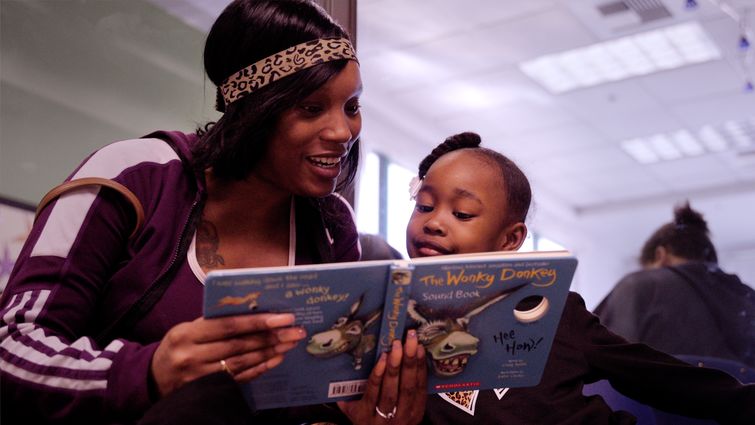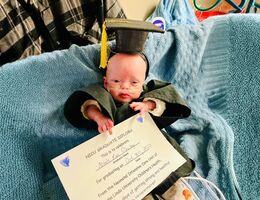

When Mikari Perkins wakes up each morning, she’s filled with energy and joy. Her favorite activities are singing, dancing, and playing with her younger sisters.
"Just by looking at her, you couldn't even tell something was wrong with her," says Kevisha Sumins, Mikari's mom. "You would think that she's perfectly fine. She's a healthy child, but it started with her breathing."
Despite outwardly appearing healthy, Mikari's breathing indicated a deeper issue. Mikari was two years old when Kevisha took her to a local hospital, where doctors discovered she had an enlarged heart. She was then transferred to Loma Linda University Health, where doctors said she had heart failure and was diagnosed with dilated cardiomyopathy, a condition where the heart becomes ballooned, thin, and weakened, affecting its pumping ability.
Natalie Shwaish, MD, a pediatric cardiologist at Children's Hospital, recalls Makari's initial condition.
"When I first met her, she was already quite sick and very small," says Shwaish. "When I saw the ultrasound of her heart, I saw that it wasn't squeezing hardly at all, that's what concerned me the most."
The initial treatment involved monitoring and medication. Although the medication helped Mikari for two years, her rapid breathing prompted a hospital visit.
"Unfortunately, with medicines alone, we were not able to get her to where she could thrive and survive. She needed a new heart," says Shwaish.
Makari was placed on the heart transplant waiting list but required the support of a Berlin Heart, a mechanical ventricular assist device to keep her alive until a heart was available.
"They told me that if she doesn't get a heart within the next year or the next few months, she's gonna die," says Kevisha. "I was so scared. When Dr. Shwaish presented me with the option of the Berlin Heart, it gave us hope that there's more time."
The device remains on the outside of the body, and the surgeon inserts tubes into the heart. These tubes extract blood, pump it, and then propel it back into the body, effectively performing the functions of a heart pump. This procedure is considered high-risk and challenging, especially with a pump located outside the body of a small child who wants to move around. It's also connected to a large machine that operates the pump.
Aneez Razzouk, MD, a heart surgeon at Loma Linda University Children's Hospital, performed the implantation.
"Mikari had arrhythmias, the heart was unpredictable, she would fibrillate," says Razzouk. "When that happens, the next thing would be the heart would stop without any notice. Patients who have rhythm disturbances and heart failure are at risk of dying suddenly, and you don't know how much time they have. So those mechanical pumps cannot only save lives but also improve the quality of time and quality of life while waiting."
After deciding to implant a mechanical device, a collaborative team guides families through the process, including a specialized nurse educator known as a ventricular assist device coordinator. This involves providing extensive materials, answering questions, and instructing on care procedures, such as dressing changes and infection prevention. The team's efforts extend to various professionals, including those from the blood bank, ensuring a suitable supply, dieticians advising on dietary choices, and pharmacists reviewing medications.
"She started to feel a lot better having a pump work her and became the joy of the ICU," says Shwaish. "We would have dance parties and walk laps to strengthen her for the transplant. Child Life was incredible during this journey. They would set up little figurines for a scavenger hunt in the hallways at the ICU. Macari would go with her whole team rolling around with the big machine to find the little Elsa princess hidden on the door handle."
Mikari spent five months in the hospital, including her birthday. On November 8, doctors informed the family that a heart was available, and she underwent surgery the next day.
"It was the best feeling ever! I was so full of joy. I was so happy and just crying tears of joy," Kevisha says.
Makari didn't have any complications from her Berlin Heart pump, so when the right heart came for her, she was ready.
"The waitlist for a heart transplant is challenging because if you're sick enough to need a heart transplant, you often don't have time to wait,” Shwaish says.
Nearly 2,000 children are on the waitlist for a variety of organs, including 475 who are under 5 years old, according to Donate Life America. Medical experts say there’s a lack of education and misunderstanding surrounding organ donation, and families only receive education after a tragic event happens to their child.
“Children and adults are not surviving until transplant because we don't have enough donors."
After her heart transplant, Mikari remained in the hospital for a few additional weeks and currently attends regular outpatient visits. At the age of six, she is now actively engaged in school. Looking ahead, Kevisha envisions traveling around the world with her daughter.
"It amazes me how much she's matured after having this heart transplant,” says Kevisha. “She's so healthy now. I'm so happy to be her mom. I'm so in love with my daughter. She's my life."
Loma Linda University Children's Hospital has been ranked #22 in the nation for pediatric cardiology and heart surgery by U.S. News & World Report. To make an appointment for specialized care or to see a primary care pediatrician, visit online.


